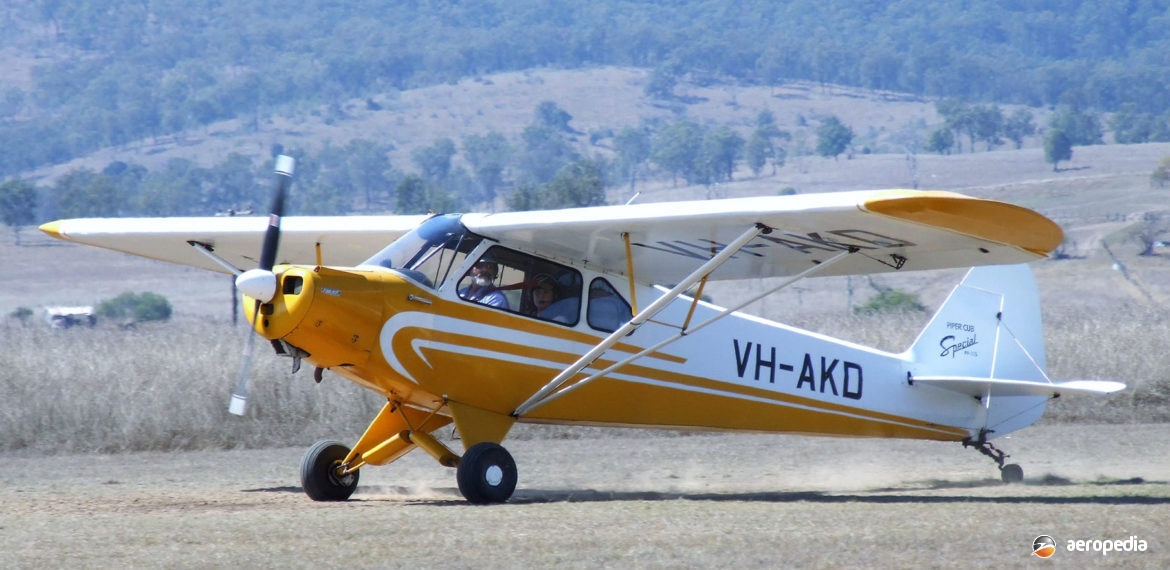Photograph:
Piper PA-11S Cub Special VH-AKD (c/n 11-894) at Watts Bridge, QLD in August 2006 (David C Eyre)
Country of origin:
United States of America
Description:
Two-seat light cabin monoplane
Power Plant:
One 48 kw (65 hp) Continental A65-8 four-cylinder horizontally-opposed air-cooled engine
Specifications:
- Wingspan: 11.02 m (36 ft)
- Length: 6.86 m (22 ft 6 in)
- Height: 2.08 m (6 ft 10 in)
- Wing area: 17.00 m² (183 sq ft)
- Max speed: 161 km/h (100 mph)
- Cruising speed: 140 km/h (87 mph)
- Stalling speed: 61 km/h (38 mph)
- Rate of climb at sea level: 157 m/min (514 ft/min)
- Service ceiling: 4,267 m (14,000 ft)
- Range: 547 km (340 miles)
- Fuel capacity: 62 litres (14 Imp gals)
- Take-off roll: 107 m (350 ft)
- Landing roll: 88 m (290 ft)
- Empty weight: 331 kg (730 lb)
- Useful load: 222 kg (490 lb)
- Loaded weight: 553 kg (1,220 lb)
History:
The first Cub was the E-2, designed by the brothers Clarence Gilbert and Gordon Taylor, and it was powered by the Brownbach Kitten engine, eventually replaced by the Continental Motors A-40 of 28 kw (37 hp). Eventually the brothers met W T Piper and the series was developed through a number of models. The U S Army purchased 5,673 Cubs between 7 December 1941 and VJ Day but after the war the Company closed down for a period. After re-financing, the Company produced the PA-11 Cub Special and the Vagabond, eventually going on to the Super Cub series, the PA-11S being aimed at the floatplane market in the United States.
The PA-11 appeared at the end of World War II but soon ran into problems with the availability of war-surplus aircraft coming on to the market. Piper decided to build a civil version of the L-4 Grasshopper initially with a 48 kw (65 hp) Continental A65-8 four-cylinder engine and its price in 1947 was only slightly above the price of an ex-military aircraft the history of which could not be confirmed. A total of 1,323 examples was built; and many were supplied to other nations under the US Military Aid Programme, 105 being built with the 71 kw (95 hp) Continental C90-8F engine for service in Turkey under the designation L-18B.
The PA-11 received some development during its production life, the 1949 model becoming known as the PA-11 Trainer, production continuing at that time at Lock Haven, Pennsylvania. Three basic models were produced. The PA-11 had the 48 kw (65 hp) Continental A65-8 or the 67 kw (90 hp) Continental C90-8. The PA-11X had a 63 kw (85 hp) Continental C85-8FJ, this model being aimed at military service as the L-16 but lost out to the Aeronca 7BC Champ for a contract. In the event the US Army later ordered 105 of the L-18B with extended cabin glazing and the 48 kw (65 hp) Continental engine, these being supplied to Turkey under the European Recovery Program.
Two examples of the PA-11 series appear on the Australian civil register. The first aircraft VH-AKD (c/n 11-894 – ex VQ-FAI) is a PA-11S Cub Special which operated for part of its life on floats powered by a 67 kw (90 hp) Continental C-90-8 engine. Over the years a number of aircraft have operated from Merimbula, NSW and Port Lincoln, SA supporting the fishing fleet, fish spotting by light aircraft becoming part of the industry. This was pioneered in the 1950s by single-engine floatplanes and VH-AKD was used for these operations for many years until larger twin-engined aircraft took over. This aircraft was built at Lock Haven, Pennsylvania in 1949 with the manufacturing date being 14 January that year.
It was exported to Fiji and registration VQ-FAI was issued on 13 August to South Sea Marine Products Ltd of Suva. It arrived in Sydney on board the tuna vessel Senibua on 24 September 1950 and was registered VH-AKD on 5 January 1951, owned by R J Herpes and E “Brud” Rees of North Brighton Le Sands, NSW. Ownership was transferred to Warren-Fourter-Warren of Eden, NSW for further fish spotting until it was withdrawn from service for overhaul in August 1957.
In the 1950s it was noted giving joy-riding flights on the south coast of New South Wales. It returned to the register in December 1960. It was re-built in the 1970s, returning to the register on 1 May 1975, and operated as a landplane in Queensland. A second PA-11 was registered in November 1992 as VH-AGC (c/n 11-1628 – ex N4918M) and has been based at Young, NSW.

